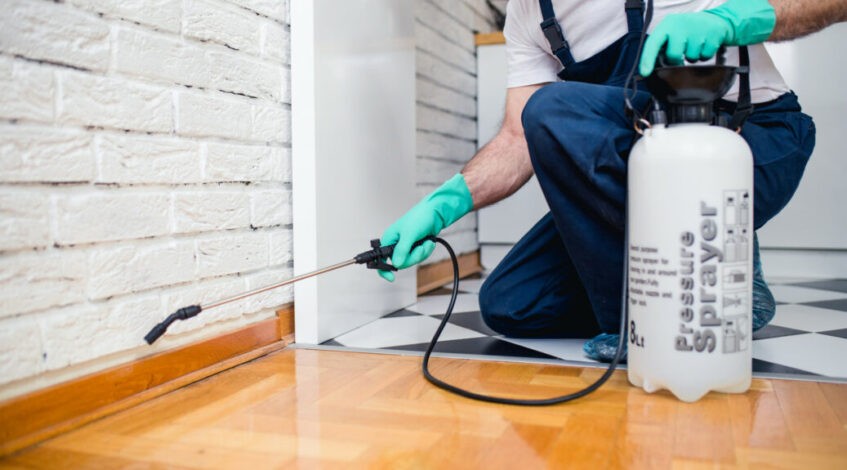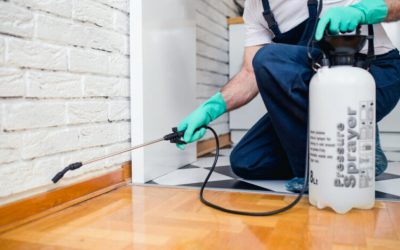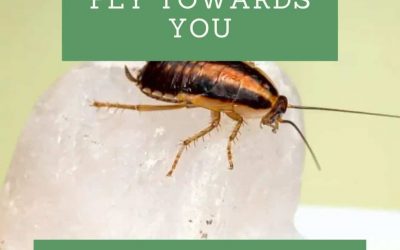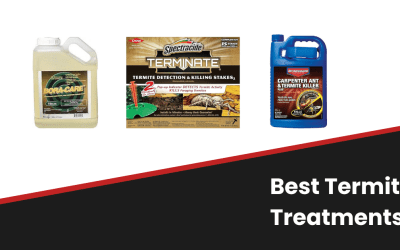Termite Tenting

Termite tenting in Los Angeles. Source: Wikipedia
One termite treatment that many homeowners go for is what is known as tenting. This is where the home is covered in a sealed, nylon tent. Then the home is filled with a poisonous gas that kills the termites. This gas used is typically sulfuryl fluoride, which has no smell and no color, and doesn’t leave behind a residue. However, if it is left long enough within the home, it can penetrate any wood in the home to get to the termites living within. By sealing the bugs in with the tent, the escape or entry of any termites is prevented, ensuring that the termite population has been completely eradicated. In order to ensure that the gas reaches all areas of the home, fans are typically used to circulate the air throughout. These are also installed by the service provider as part of the process.
At the end of the two days, the tent is removed, the house is aired out, and the quality of the air is tested to see if it is safe for the homeowner to return. This process tends to take one or two days to ensure that all of the termites and their eggs are killed, meaning that the homeowner, his family, and any pets should be eradicated from the home at this time. Food, medicine and any house plants should be removed from the home entirely. Some fumigation services may even provide special bags for these items to be stored in, should the homeowner be incapable of taking these things with him. Surfaces where a person may spend extended periods of times being in contact with are also covered, such as beds and sofas.
Despite the effectiveness of this process, there are some drawbacks to its use.
- The tenting method is only effective against drywood termites. This can make if a very expensive ordeal if the process doesn’t work due to the fact that it is a different kind of infestation.
- The termite treatment of gas is not effective against the eggs, and is only capable of killing the adults. However, if the process has been successful, then there would be no adults to feed the nymphs once they hatch.
- At very high temperatures, the sulfuryl fluoride will decompose into a corrosive acid that can eat through the home’s surfaces and structure, causing more damage than originally intended. It’s important that the service provider you hire is experienced in the tenting process and removes any heat sources from the home before the fumigation process begins.
- The tenting process may not be capable of killing the termites that are deep within the foundation of the home in the soil itself. This incomplete eradication will only make it easier for the termites to remain within the “safe” zones of your home and continue to increase their numbers.
- Lastly, the gas does not prevent a new infestation from occurring. Once the home is reopened, a new colony is free to retake residence within your home once it has been aired out. This is a sign that there is a bigger problem that must be dealt with using more serious methods to completely eliminate the termite presence in your home altogether, and can make getting rid of termites more difficult than you already bargained for.
Killing termite with chemical treatments
Amongst the termite treatment options are a variety of chemical treatments that can be applied to the home and the surrounding areas in order to keep termites away. These treatments technically come in two varieties: repellant and non-repellant.
Repellants are typically used within the home itself and in the soil found deep underground surrounding the home. These are the most common type of chemical treatment, as it creates a barrier that termites are not likely to cross to enter the home. The chemical is applied to as many termite entry points are possible in order to prevent the population from increasing. However, this is not very effective against killing the termites that are near the home, as the product only works on those who come into contact with the chemical. All of the entry points may also be impossible to locate, leaving the home vulnerable in these areas that termites can still use to eat through your foundation and make it their new home.
Non-repellants work in a much different way. How this is works is that the chemical that is used cannot be detected by the termites, so they are unaware they are burrowing into the treated area, effectively killing their numbers without them knowing. An added bonus is that the chemical can be transmitted from termite to termite, affecting even those termites that are outside of the treatment zone. This seems to be a much more effective method of quelling a population’s numbers until they have been completely eradicated.
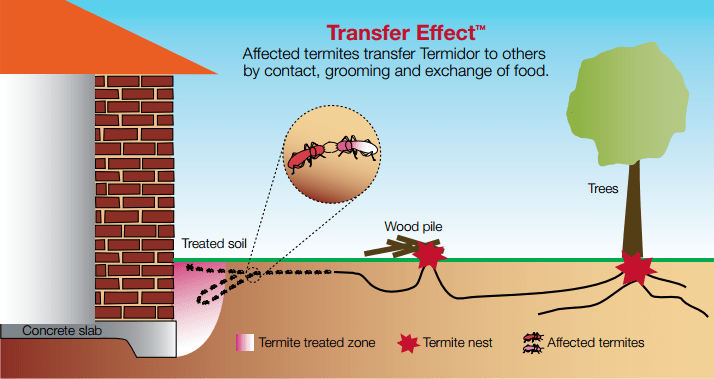
Chemical Termite Treatments. Source: Termidor
These chemical treatments can be applied to a number of different building materials throughout the home, either pre- or post-construction in order to prevent or deal with an existing termite infestation.
The treatment of any wood within the home is typically the first step, as wood foundation are the most vulnerable to attack by termites. Such treatment can also be applied to the siding and sheetrock of the home in order to further prevent any termites from settling within the structure. This chemical treatment is typically done with disodium octoborate-tetrahydrate, which prevents termites from feeding and constructing shelter tubes. However, this only prevents the construction of the mud tubes; there may still be infestation within the home even without their presence.
Chemical barriers can also be made by applying treatments to the surrounding soil of the home, but internally and externally. This kind of treatment is performed during the process of building the home, and has a number of stages that need to be adhered to. It’s a treatment that requires a lot of chemical product, so it is not a do-it-yourself project that most homeowners can do on their own.
Termite Baiting
In knowing how to get rid of termites, it’s important to know all of the options that are available to you. Termite baiting is certainly an attractive option for homeowners who aren’t interested in filling their home with a lot of poisonous chemicals. Termite baiting is a simple process that can eliminate termites in one’s home forever, and it’s not very expensive.
The baits themselves can be installed above ground or below ground, depending on the homeowner’s personal preference. In above ground, the “stations” are placed directly over the signs of active termite activity, such as wood and drywall. Below ground treatment, however, dispense the bait randomly, producing a chance that the termites will find it. It’s easy to see why the former is a more attractive option in dealing with these pests. To increase the effectiveness of below ground treatment, more “stations” would have to be installed to increase the likelihood of the bait being taken and consumed.
Termite baiting works by the installation of stations that deposit attractive material for the termites to eat. This bait typically consists of cardboard, paper, and other substances that termites would readily eat. Combined with this material is a substance that is lethal to termites, and is slow-acting. This ensures that the termites will bring the food back to its nest and share with the rest of the population, increasing the chances that the other termites will also ingest the material. If it were to kill them too quickly, then the rest of the termites would learn to avoid these areas where the sick or dead termites are accumulating.
How to get rid of specific termites types
How to get rid of drywood termites
In discovering what kills termites, it’s important to note what kind of infestation you have in your home, for one treatment may only work on flying termites, for example, and not drywood termites or subterranean termites. To tell the difference, there are some characteristics of the drywood termite that should be noted.
There are typically three kinds of drywood termites: workers, soldiers and reproductives. Workers are roughly an eighth of an inch, are without wings, and are typically white in colour. Soldiers are much the same, except that have large brown heads, and jaws that they use to defend the population. Reproductives are the only ones with wings, and range from dark brown to black in colour. The reproductives make it easy to tell what kind of infestation you have, as there will be the presence of shed wings. Other signs to look for as ejected wood pellets and fecal pellets outside of elongated wood galleries. Drywood termites also focus their efforts on the undecayed, dry wood in your home, meaning that you won’t find them in the subterranean areas of your home and in the soil, where the most damage can be done to the integrity of the home’s structure.
There are several recommended treatment options when trying to figure out how to get rid of termites that are available for dealing with drywood termites. The first such method is known as tenting or structural fumigation. The entire building is covered with an air-tight tent, and sulfuryl fluoride is pumped throughout the house to kill any drywood termite infestations.
Another method is the application of a borate preservative directly into the termite’s nest. Small spots of infested wood are drilled into and the toxin injected in order to kill off their numbers. This chemical can also be applied to the untreated wood before an infestation even occurs. Borate preservative is designed to last for the life of the structure, so they may never be the need to reapply in the future. It’s also safe to be used around people and pets, which makes it a much more attractive option than tenting.
Subterranean termites treatment
Knowing how to kill termites in your house may seem simple at first, but it’s can be more difficult than you think if you’re not aware of the kind of termites infecting your home. The characteristics of drywood termites have already been discussed, so it is time to examine their “cousin”, the subterranean termite.
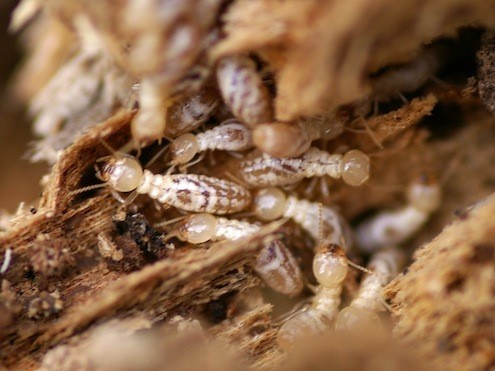
Subterranean termite treatment.
Subterranean termites are much different from drywood termites, in that require a moist environment in order to survive. They will typically enter your home through plumbing fixtures and cracks in the foundation on the outside of your home. The more moisture there is in the surrounding area, the more likely they are to deem this area suitable for habitation.
The first sign you’ll see of subterranean termite are shelter tubes made of mud that they build towards and around their food source. Damaged wood and discarded wings are also signs to look for, as the reproductive termites shed their wings after they have finished mating. These wings are shaped much differently from those of drywood termites, as they are much longer and more evenly sized with each other. Subterranean termites tend to swarm during the day, while drywood termites swarm at night, making it easier to notice the wings during a time of the day when action can be taken.
The most common treatment used for subterranean termites in figuring out how to get rid of termites are the application of liquid repellants to the perimeter of the home and the surrounding area (to keep the termites away), liquid non-repellants (to ensure that the chemical is brought back to the nest and destroys the population), and termite baiting. These subterranean termite treatment options can be applied to the mud shelters or “trenches” that they’ve built as well, since these areas are where they tend to use the most in going back and forth between their food supply and their nests.
Flying Termites Treatment
Though many homeowners have come to believe that flying termites are a separate species from all others, this simply isn’t true. Flying termites are simply a stage of the reproductive termites. The wings grow in for this purpose only and fall off once it has passed. Afterwards, the termites will look for somewhere else to expand their colony, so if there is the presence of discarded wings around your home, then it’s likely that they have decided to take roost within.
They are often times confused with flying ants; the biggest difference is that flying termites only have two body sections, while flying ants have three. A second key factor is that a termites wings are all the same size, while an ant will have two sets of wings that vary in size.
Flying termites are probably the easiest to get rid, since they are more likely to be out in the open while they are trying to reproduce. If you’re focusing on killing this stage of termites, then you can simply place a bug zapper near the entry points they’re using to get into your home. They are attracted to light, and will fly right into the device.
A fly swatter can also be used to kill them physically if you find them in your home, and vacuumed up from your carpets and floors. This process can be quite tiresome and take several days to accomplish, but the only thing you’ll have to purchase is the fly swatter itself, which is quite cheap and rarely ever needs replacing.
However, the presence of flying termites is a sign that you have a bigger problem on hand, and requires more drastic measures to be taken in eliminating the colony altogether. Simply getting rid of the flying termites won’t fix the problem in one fell swoop. Baiting systems placed around the perimeter of your home and the application of liquid termite chemicals to the soil outside are effective methods of preventing and killing a termite infestation within your home.

